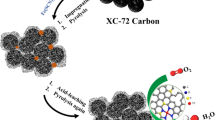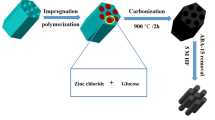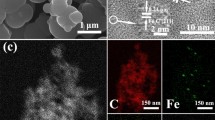Abstract
Synthesis and characterization of a cost-effective electrocatalyst for oxygen reduction reaction (ORR) are attempted for sustainable development in energy storage protocol. Ordered mesoporous carbon (OMC) has emerged as a promising candidate for such purposes, particularly in alkaline conditions. However, the scarceness of active sites is responsible for considerably lower catalytic performance of OMC. Herein, we report a new facile route to synthesize α-Fe2O3 nanoparticles supported on ordered mesoporous carbons forming a new hybrid ORR catalyst. This catalyst displayed excellent catalytic properties, long-term stability and impressive methanol tolerance.







Similar content being viewed by others
References
Debe MK (2012) Electrocatalyst approaches and challenges for automotive fuel cells. Nature 486:43–51
Gasteiger HA, Kocha SS, Sompalli B, Wagner FT (2005) Activity benchmarks and requirements for Pt, Pt-alloy, and non-Pt oxygen reduction catalysts for PEMFCs. Appl Catal B Environ 56:9–35
Bing YH, Liu HS, Zhang L, Ghosh D, Zhang JJ (2010) Nanostructured Pt-alloy electrocatalysts for PEM fuel cell oxygen reduction reaction. Chem Soc Rev 39:2184–2202
Jang BC, Bong SY, Woo S, Park SK, Ha J, Choi E, Piao YZ (2014) Facile synthesis of one- dimensional iron-oxide/carbon hybrid nanostructures as electrocatalysts for oxygen reduction reaction in alkaline media. J Nanosci Nanochnol 12:8852–8857
Sun M, Zhang G, Liu HJ, Liu Y, Li JH (2015) α- and γ-Fe2O3 nanoparticle/nitrogen doped carbon nanotube catalysts for high-performance oxygen reduction reaction. Sci China Mater 58:683–692
Choi CH, Lee SY, Park SH, Woo SI (2011) Highly active N-doped-CNTs grafted on Fe/C prepared by pyrolysis of dicyandiamide on Fe2O3/C for electrochemical oxygen reduction reaction. Appl Catal B Environ 103:L362–L368
Sun M, Dong YZ, Zhang G, Qu JH, Li JH (2014) alpha-Fe2O3 spherical nanocrystals supported on CNTs as efficient non-noble electrocatalysts for the oxygen reduction reaction. J Mater Chem A 2:13635–13640
Ren SZ, Ma SB, Yang Y, Mao Q, Hao C (2015) Hydrothermal synthesis of Fe2O3/polypyrrole/graphene oxide composites as highly efficient electrocatalysts for oxygen reduction reaction in alkaline electrolyte. Electrochim Acta 178:179–189
Qiu KP, Chai GL, Jiang CR, Ling M, Tang JW, Guo ZX (2016) Highly efficient oxygen reduction catalysts by rational synthesis of nanoconfined maghemite in a nitrogen-doped graphene framework. ACS Catal 6:3558–3568
Kenichi SMZ, Lior S, Richard GC (2016) Innovative catalyst design for the oxygen reduction reaction for fuel cells. Chem Sci 7:3364–3369
Zhou ZX, He F, Shen YF, Chen XH, Yang YR, Liu SQ, Mori T, Zhang YJ (2017) Coupling multiphase-Fe and hierarchical N-doped graphitic carbon as trifunctional eletrocatalysts by supramolecular preorganization of precursors. Chem Commun 53:2044–2047
He F, Chen XH, Shen YF, Li Y, Liu A, Liu SQ, Mori T, Zhang YJ (2016) lonic liquid-derived Fe-N/C catalysts for highly efficient oxygen reduction reaction without any supports, templates, or multi-step pyrolysis. J Mater Chem A 4:6630–6638
Gusmao R, Sofer Z, Sembera F, Janousek Z, Pumera M (2015) Electrochemical fluorographane: hybrid electrocatalysis of biomarkers, hydrogen evolution, and oxygen reduction. Chem Eur J 21:16474–16478
Zhang YJ, Fugane K, Mori T, Niu L, Ye JH (2012) Wet chemical synthesis of nitrogen-doped graphene towards oxygen reduction electrocatalysts without high-temperature pyrolysis. J Mater Chem 22:6575–6580
Liang J, Du X, Gibson C, Du XW, Qiao SZ (2013) N-doped graphene natively grown on hierarchical ordered porous carbon for enhanced oxygen reduction. Adv Mater 25:6226–6231
Li BB, Liang YQ, Qiao SZ (2015) MoO2–CoO coupled with a macroporous carbon hybrid electrocatalyst for highly efficient oxygen evolution. Nanoscale 7:16704–16714
Zheng Y, Jiao Y, Chen J, Liu J, Liang J, Du AJ, Zhang WM, Zhu ZH, Smith SC, Joroniec M, Lu GQ, Qiao SZ (2011) Nanoporous graphitic-C3N4@Carbon metal-free electrocatalysts for highly efficient oxygen reduction. J Am Chem Soc 133:20116
Liu RL, Wu DQ, Feng XL, Müllen K (2010) Nitrogen-doped ordered mesoporous graphitic arrays with high electrocatalytic activity for oxygen reduction. Angew Chem Int Ed 49:2565–2569
Pu ZH, Amiinu IS, Wang M, Yang YS, Mu SC (2016) Semimetallic MoP2: an active and stable hydrogen evolution electrocatalyst over the whole pH range. Nanoscale 8:8500–8504
Yan S, Zan GT, Wu QS (2015) An ultrahigh-sensitivity and selective sensing material for ethanol: alpha-/gamma-Fe2O3 mixed-phase mesoporous nanofibers. Nano Res 8:3673–3686
Wang Z, Chen T, Chen WX, Chang K, Ma L, Huang GC (2013) CTAB-assisted synthesis of single-layer MoS2–graphene composites as anode materials of Li-ion batteries. J mater chem A 1:2202–2210
Huang GC, Chen T, Chen WX, Chang K, Ma L, Huang FH, Lee JY (2013) Graphene-like MoS2/graphene composites: cationic surfactant-assisted hydrothermal synthesis and electrochemical reversible storage of lithium. Small 9:3693–3703
Casillas G, Peng ZW, Ruan GD, Wang G, Yacaman MJ, Tour JM (2014) Three-dimensional nanoporous Fe2O3/Fe3C-graphene heterogeneous thin films for lithium-ion batteries. ACS Nano 8:3939–3946
Cho JS, Hong YJ, Kang YC (2015) Design and synthesis of bubble-nanorod-structured Fe2O3-carbon nanofibers as advanced anode material for Li-ion batteries. ACS Nano 9:4026–4035
Lan HC, Wang AM, Liu RP, Liu HJ, Qu JH (2015) Heterogeneous photo-Fenton degradation of acid red B over Fe2O3 supported on activated carbon fiber. J Hazard Mater 285:167–172
Shao J, Zhang JX, Jiang JJ, Zhou GM, Qu MZ (2011) Alpha-Fe2O3@CNSs nanocomposites as superior anode materials for lithium-ion batteries. Electrochim Acta 56:7005–7011
Darezereshki E, Bakhtiari F, Vakylabad AB, Hassani Z (2013) Single-step synthesis of activated carbon/gamma-Fe2O3 nano-composite at room temperature. Mater Sci Semicond Process 16:221–225
Mou FZ, Guan JG, Xiao ZD, Sun ZG, Shi WD, Fan XA (2011) Solvent-mediated synthesis of magnetic Fe2O3 chestnut-like amorphous-core/gamma-phase-shell hierarchical nanostructures with strong As(V) removal capability. J Mater Chem 21:5414–5421
Yamashita T, Hayes P (2008) Analysis of XPS spectra of Fe2+ and Fe3+ ions in oxide materials. Appl Surf Sci 254:2441–2449
Yang W, Fellinger TP, Antonietti M (2011) Efficient metal-free oxygen reduction in alkaline medium on high-surface-area mesoporous nitrogen-doped carbons made from ionic liquids and nucleobases. J Am Chem Soc 133:206–209
De Groot MT, Merkx M, Wonders AH, Koper MTM (2005) Electrochemical reduction of NO by hemin adsorbed at pyrolitic graphite. J Am Chem Soc 127:7579–7586
Acknowledgements
This work is financially supported by the National Natural Science Foundation of China (51402211) and Natural Science Foundation of Tianjin (15JCQNJC03600).
Author information
Authors and Affiliations
Corresponding author
Additional information
An erratum to this article is available at http://dx.doi.org/10.1007/s10853-017-1257-5.
Rights and permissions
About this article
Cite this article
He, J., Li, B., Mao, J. et al. Four-electron oxygen reduction from mesoporous carbon modified with Fe2O3 nanocrystals. J Mater Sci 52, 10938–10947 (2017). https://doi.org/10.1007/s10853-017-1192-5
Received:
Accepted:
Published:
Issue Date:
DOI: https://doi.org/10.1007/s10853-017-1192-5




